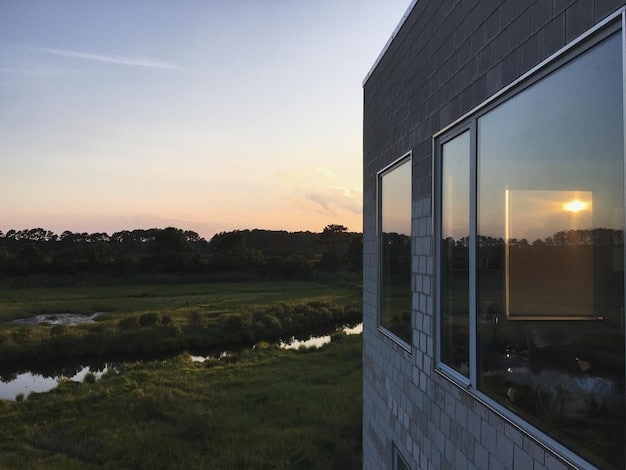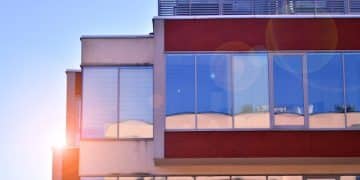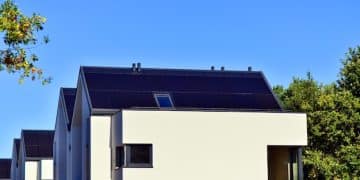Energy-Efficient Windows: Slash Heat Loss & Save Money in the US

Energy-efficient windows leverage cutting-edge technologies like low-E coatings, gas fills, and improved frame materials to minimize heat transfer, potentially reducing heat loss by 40% and delivering significant energy savings for US homeowners.
Are you looking to lower your energy bills and create a more comfortable home environment? Energy-efficient windows offer a compelling solution, combining innovative technologies to significantly reduce heat loss and save US homeowners money.
Discover the Advantages of Energy-Efficient Windows
Investing in energy-efficient windows isn’t just about upgrading your home; it’s about making a smart financial decision that benefits both your wallet and the environment. These windows are designed to minimize energy waste, keeping your home comfortable year-round.
Understanding the Core Technologies
Several key technologies contribute to the superior performance of energy-efficient windows. Let’s explore some of the most important features:
- Low-E Coatings: These microscopically thin coatings reduce the amount of ultraviolet and infrared light that can pass through the glass, minimizing heat gain in the summer and heat loss in the winter.
- Gas Fills: Inert gases like argon or krypton are often used between the panes of glass to provide additional insulation, reducing heat transfer. Tests show adding gas fills can decrease heat loss by up to 40%.
- Improved Frame Materials: Modern window frames made of materials like fiberglass, vinyl, or wood offer better insulation than traditional aluminum frames, further preventing heat loss.
By understanding these technologies, homeowners can make informed decisions about the best energy-efficient windows for their specific needs and climate.

Evaluate the Energy Performance Ratings
Understanding energy performance ratings is crucial for comparing different window models and selecting the most efficient option for your home. Several key metrics are used to assess a window’s energy efficiency.
The National Fenestration Rating Council (NFRC) provides standardized ratings that allow consumers to compare different windows. Look for windows with low U-factors and Solar Heat Gain Coefficients (SHGC) for optimal energy savings.
Key Metrics to Consider
Navigating the maze of numerical ratings can feel overwhelming. Let’s break down the most important metrics:
- U-Factor: Measures how well a window insulates. Lower numbers indicate better insulation. A lower U-factor suggests less heat transfer.
- Solar Heat Gain Coefficient (SHGC): Measures how much solar radiation passes through the window. Lower numbers mean less solar heat gain, which is ideal for hot climates.
- Visible Transmittance (VT): Measures how much visible light passes through the window. A higher VT indicates more natural light.
Understanding these ratings helps you choose windows that meet your specific energy-saving goals and climate needs.
Choosing the Right Window Materials
The frame material of your windows can significantly impact their energy efficiency and overall performance. Different materials offer varying levels of insulation and durability.
Selecting the right frame material is essential for maximizing energy savings and ensuring that your windows last for years to come. Consider climate conditions, budget, and aesthetic preferences to make the best choice.
Common Window Frame Materials and Their Benefits
Each window frame material presents unique advantages. Here’s a brief comparison:
- Vinyl: Offers excellent insulation, low maintenance, and affordability.
- Fiberglass: Provides superior strength, durability, and resistance to temperature changes.
- Wood: Offers natural beauty and good insulation, but requires more maintenance.
The best choice depends on factors like climate, budget, and aesthetic preferences. Vinyl windows work best in milder temperatures, while fiberglass can withstand more extreme weather.

Calculate the Potential Cost Savings
Calculating the potential cost savings from energy-efficient windows can help justify the initial investment. The amount you save depends on factors like your climate, home size, and current energy usage.
By understanding the factors that influence energy savings, homeowners can accurately estimate the potential return on investment (ROI) of upgrading to energy-efficient windows.
Estimating Your ROI
The return on investment (ROI) from energy-efficient windows should be carefully considered. Here’s what to keep in mind:
- Energy bills should decrease.
- You will be more comfortable inside your home.
- Consider home value in the equation as well.
Many online calculators and resources are available to help you estimate your potential cost savings. You can also consult a professional energy auditor for a more accurate assessment. Your energy savings may also qualify you for a tax payback.
Navigating Available Rebates and Incentives
Many government and utility programs offer rebates and incentives to encourage homeowners to invest in energy-efficient upgrades, including windows. These programs can help offset the initial cost of new windows.
Taking advantage of these financial incentives can make energy-efficient windows even more affordable and accelerate your return on investment.
Finding Available Programs
Discovering potential rebates may take some initial investigation. Some suggestions would include:
- Visit websites like the Department of Energy’s database of state incentives for renewables and efficiency (DSIRE).
- Explore ENERGY STAR’s website.
- Refer to various utility companies’ websites.
Navigating the maze of rebate programs may seem daunting, but the potential savings make the effort worthwhile.
Proper Installation for Optimal Performance
Even the most energy-efficient windows won’t perform optimally if they’re not installed correctly. Proper installation is crucial for ensuring that your windows are airtight and effectively reduce heat loss.
Investing in professional installation is a worthwhile expense that guarantees your windows perform as intended and maximize energy savings.
Avoiding Installation Pitfalls
Many installation errors can happen that you should be aware of:
- Improper Sealing: Gaps around the window frame can compromise insulation.
- Incorrect Flashing: Improper flashing can lead to water damage and air leaks.
- Poor Alignment: Misaligned windows can cause drafts and operational problems.
You can expect properly installed windows to be a worthwhile investment if they improve energy-efficiency.
| Key Point | Brief Description |
|---|---|
| 💡 Low-E Coatings | Reduce UV and infrared light, minimizing heat transfer. |
| 💨 Gas Fills | Inert gases like argon or krypton provide additional insulation. |
| 💰 Cost Savings | Lower energy bills and potential tax credits and rebates. |
| 🛠️ Proper Installation | Essential for windows to perform optimally. |
Frequently Asked Questions
Energy-efficient windows use technologies such as low-E coatings, gas fills, and insulated frames to minimize heat transfer, thereby reducing heat loss in winter and heat gain in summer.
Low-E (low-emissivity) coatings are thin, transparent layers applied to the glass surface that reflect infrared light, reducing heat transfer through the windows and improving energy efficiency.
Gas fills, like argon or krypton, replace the air between the panes of glass, providing better insulation because these gases are denser and conduct heat less efficiently than air.
The lifespan of energy-efficient windows typically ranges from 15 to 30 years, depending on the quality of materials, installation, and maintenance. Regular maintenance can extend their lifespan.
Yes, energy-efficient windows are worth the investment as they reduce energy bills, increase home comfort, and potentially increase property value. They offer long-term savings and sustainability benefits.
Conclusion
Energy-efficient windows are a smart investment for US homeowners looking to reduce energy costs, improve home comfort, and promote environmental sustainability. By understanding the technologies, ratings, and installation requirements, you can make informed decisions and enjoy the long-term benefits of a more energy-efficient home.





